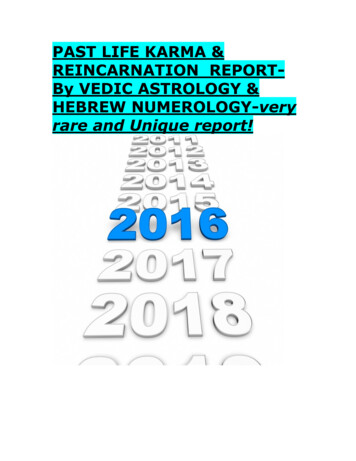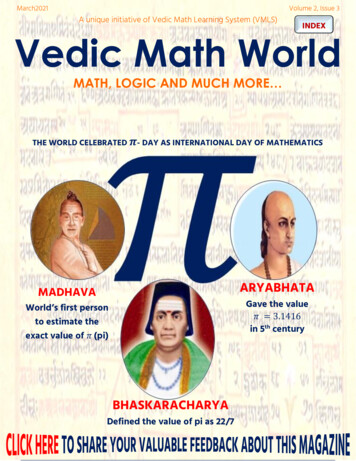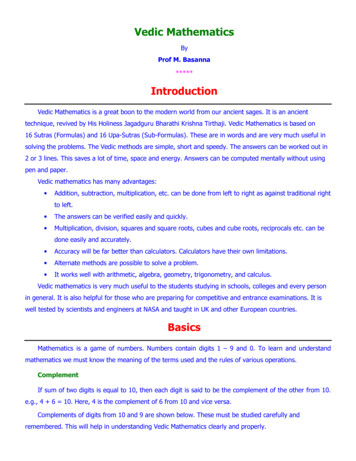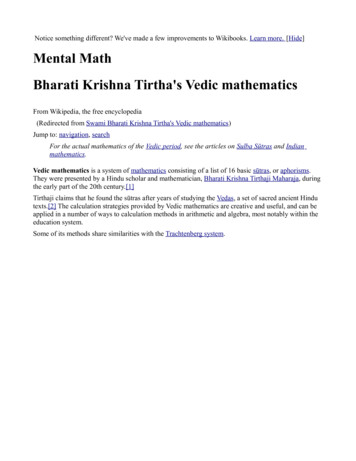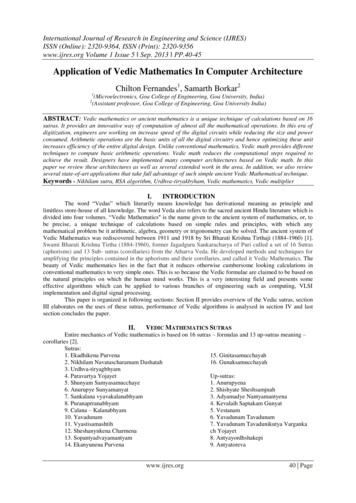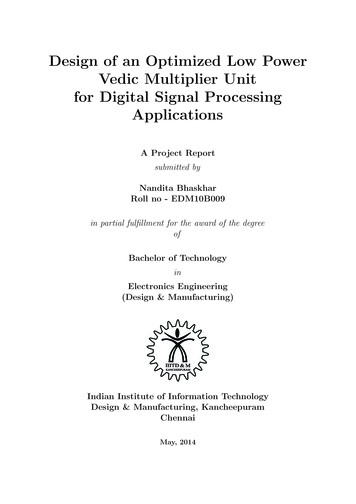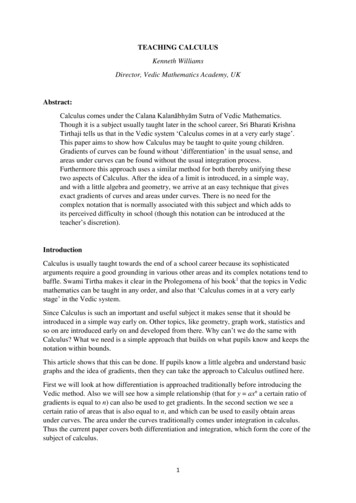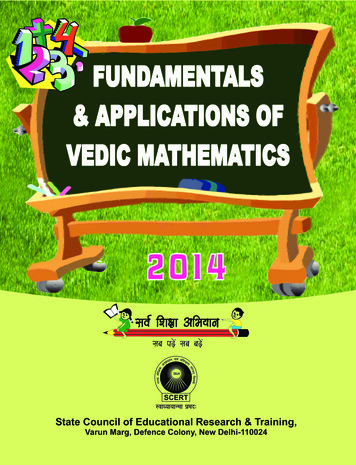
Transcription
FUNDAMENTALS&APPLICATIONS OFVEDIC MATHEMATICS2014State Council of Educational Research & TrainingVarun Marg, Defence Colony, New Delhi-110024
Chief AdvisorAnita SatiaDirector, SCERTGuidanceDr. Pratibha Sharma,Joint Director, SCERTContributorsDr. Anil Kumar TeotiaNeelam KapoorChander Kanta ChabriaRekha JollyDr. Satyavir SinghSr. Lecturer, DIET Dilshad GardenRetired PGT, Directorate of EducationPGT, RPVV Tyagraj Nagar, Lodhi RoadTGT, RPVV Vasant KunjPrincipal SNI College PilanaEditorDr. Anil Kumar TeotiaSr. Lecturer, DIET Dilshad GardenPublication OfficerMs. Sapna YadavPublication TeamNavin Kumar, Ms. Radha, Jai BaghwanPublished by : State Council of Educational Research & Training, New Delhi and printed atEducational Stores, S-5, Bsr. Road Ind. Area, Ghaziabad (U.P.)
PrefaceVedic Mathematics introduces the wonderful applications to Arithmetical computations, theory ofnumbers, compound multiplications, algebraic operations, factorisations, simple quadratic and higherorder equations, simultaneous quadratic equations, partial fractions, calculus, squaring, cubing,square root, cube root and coordinate geometry etc.Uses of Vedic Mathematics:OIt helps a person to solve mathematical problems 10-15 times fasterOIt helps m Intelligent GuessingOIt reduces burden (need to learn tables up to 9 only)OIt is a magical tool to reduce scratch work and finger countingOIt increases concentration.OIt helps in reducing silly mistakes"Vedic Mathematics" is a system of reasoning and mathematical working based on ancient Indianteachings called Veda. It is fast, efficient and easy to learn and use. Vedic mathematics, whichsimplifies arithmetic and algebraic operations, has increasingly found acceptance the world over.Experts suggest that it could be a handy tool for those who need to solve mathematical problemsfaster by the day.Vedic Mathematics provides answer in one line where as conventional method requires several steps.It is an ancient technique, which simplifies multiplication, divisibility, complex numbers, squaring,cubing, square and cube roots. Even recurring decimals and auxiliary fractions can be handled byVedic Mathematics. Vedic Mathematics forms part of Jyotish Shastra which is one of the six partsof Vedangas. The Jyotish Shastra or Astronomy is made up of three parts called Skandas. A Skandameans the big branch of a tree shooting out of the trunk.The basis of Vedic mathematics, are the 16 sutras, which attribute a set of qualities to a number ora group of numbers. The ancient Hindu scientists (Rishis) of Bharat in 16 Sutras (Phrases) and 120words laid down simple steps for solving all mathematical problems in easy to follow 2 or 3 steps.Vedic Mathematicsor one or two line methods can be used effectively for solving divisions, reciprocals,factorisation, HCF, squares and square roots, cubes and cube roots, algebraic equations, multiplesimultaneous equations, quadratic equations, cubic equations, biquadratic equations, higher degreeequations, differential calculus, Partial fractions, Integrations, Pythogorus theoram, ApolloniusTheoram, Analytical Conics and so on.3
How fast your can solve a problem is very important. There is a race against time in all thecompetitions. Only those people having fast calculation ability will be able to win the race. Timesaved can be used to solve more problems or used for difficult problems.This Manual is designed for Mathematics teachers of to understand Vedic System of Mathematics.The Chapters developed in this Manual will give teachers the depth of understanding of the Vedicmethods for doing basic operations in Arithmetic and Algebra. Some important basic devices likeDigit Sum, the Vinculum, are also explained along with independent Checking Methods.All the techniques are explained with examples. Also the relevant Sutras are indicated along withthe problems. In Vedic System a manual approach is preferred. The simplicity of Vedic Mathematicsencourages most calculations to be carried out without the use of paper and pen. The contentdeveloped in this manual will be applicable in the curriculum of VI-X classes. Methods like ShudhMethod is applicable in statistics. This mental approach sharpens the mind, improves memory andconcentration and also encourages innovation.Since the Vedic Mathematics approach encourages flexibility, the mathematics teachers encouragetheir students to device his/her own method and not remain limited to the same rigid approach, whichis boring as well as tedious. Once the mind of the student develops an understanding of system ofmental mathematics it begins to work more closely with the numbers and become more creative.The students understand the numbers better. Vedic Mathematics is very flexible and creative andappeals to all group of people. It is very easy to understand and practice.I acknowledge a deep sense of gratitude to all the subject experts for their sincere efforts and expertadvice in developing this manual which lead to qualitative and quantitative improvement inmathematics education and may this subject an interesting, joyful and effective.Suggestions for further improvements are welcome so that in future this manual become more useful.—Anita Satia4
tion and Subtraction12-241.Addition - Completing the whole2.Addition from left to right3.Addition of list of numbers - Shudh method4.Subtraction - Base method5.Subtraction - Completing the whole6.Subtraction from left to rightChapter-2Digit Sums, Casting out 9s, 9-Check Method25-28Chapter-311-Check method29-31Chapter-4Special Multiplication methods32-52Chapter-51.Base Method2.Sub Base Method3.Vinculum4.Multiplication of complimentary numbers5.Multiplication by numbers consisting of all 9s6.Multiplication by 117.Multiplication by two-digit numbers from right to left8.Multiplication by three and four-digit numbers from right to left.Squaring and square Roots53-57Squaring1.Squaring numbers ending in 52.Squaring Decimals and Fraction5
3.Squaring Numbers Near 504.Squaring numbers near a Base and Sub Base5.General method of Squaring - from left to right6.Number splitting to simplify Squaring Calculation7.Algebraic SquaringSquare RootsChapter-61.Reverse squaring to find Square Root of Numbers ending in 252.Square root of perfect squares3.General method of Square RootsDivision1.Special methods of Division2.Straight Division58-646
IntroductionThe “Vedic Mathematics” is called so because of its origin from Vedas. To be more specific, it hasoriginated from “Atharva Vedas” the fourth Veda. “Atharva Veda” deals with the branches like Engineering,Mathematics, sculpture, Medicine, and all other sciences with which we are today aware of.The Sanskrit word Veda is derived from the root Vid, meaning to know without limit. The word Vedacovers all Veda-Sakhas known to humanity. The Veda is a repository of all knowledge, fathomless, everrevealing as it is delved deeper.Vedic mathematics, which simplifies arithmetic and algebraic operations, has increasingly foundacceptance the world over. Experts suggest that it could be a handy tool for those who need to solvemathematical problems faster by the day.It is an ancient technique, which simplifies multiplication, divisibility, complex numbers, squaring,cubing, square roots and cube roots. Even recurring decimals and auxiliary fractions can be handled byVedic mathematics. Vedic Mathematics forms part of Jyotish Shastra which is one of the six parts ofVedangas. The Jyotish Shastra or Astronomy is made up of three parts called Skandas. A Skanda meansthe big branch of a tree shooting out of the trunk.This subject was revived largely due to the efforts of Jagadguru Swami Bharathi Krishna Tirtha Jiof Govardhan Peeth, Puri Jaganath (1884-1960). Having researched the subject for years, even his effortswould have gone in vain but for the enterprise of some disciples who took down notes during his last days.The basis of Vedic mathematics, are the 16 sutras, which attribute a set of qualities to a number or a groupof numbers. The ancient Hindu scientists (Rishis) of Bharat in 16 Sutras (Phrases) and 120 words laiddown simple steps for solving all mathematical problems in easy to follow 2 or 3 steps.Vedic Mental or one or two line methods can be used effectively for solving divisions, reciprocals,factorisation, HCF, squares and square roots, cubes and cube roots, algebraic equations, multiplesimultaneous equations, quadratic equations, cubic equations, biquadratic equations, higher degreeequations, differential calculus, Partial fractions, Integrations, Pythogorus Theoram, Apollonius Theoram,Analytical Conics and so on.Vedic scholars did not use figures for big numbers in their numerical notation. Instead, they preferredto use the Sanskrit alphabets, with each alphabet constituting a number. Several mantras, in fact, denotenumbers; that includes the famed Gayatri Mantra, which adds to 108 when decoded. How fast you cansolve a problem is very important. There is a race against time in all the competitions. Only those peoplehaving fast calculation ability will be able to win the race. Time saved can be used to solve more problemsor used for difficult problems.Given the initial training in modern maths in today’s schools, students will be able to comprehendthe logic of Vedic mathematics after they have reached the 8th standard. It will be of interest to everyonebut more so to younger students keen to make their mark in competitive entrance exams. India’s past couldwell help them make it in today’s world. It is amazing how with the help of 16 Sutras and 13 sub-sutras,the Vedic seers were able to mentally calculate complex mathematical problems.7
Sixteen SutrasS.N.Sutras1.,dkf/kdsu iwoZ.s kMeaningOne more than the previous oneEkadhikena Purvena (also a corollary)2.fuf[kya uor'pjea n'kr%All from 9 and last from 10Nikhilam Navatascaramam Dasatah3.Å/oZfr;ZXH;ke Criss-cross (Vertically and cross-wise)Urdhva-tiryagbhyam4.ijkoR;Z ;kst;sr Transpose and adjust (Transpose and apply)Paravartya Yojayet5.6.'kwU;a lkE;leqPp;sWhen the samuchchaya is the same, the samuch-Sunyam Samyasamuccayechaya is zero, i.e it should be equated to zero¼vkuq:I;s½ 'kwU;eU;r If one is in ratio, the other one is zero(Anurupye) Sunyamanyat7.ladyuO;odyukH;ke By addition and by subtractionSankalana-vyavakalanabhyam(also a corollary)8.iwj.kkiwj.kkH;ke By the completion or non-completionPuranapuranabhyam9.pyudyukH;ke By CalculusCalana-Kalanabhyam10-;konwue By the deficiencyYavadunam11.O;f"Vlef"V%Specific and General (Use the average)Vyastisamastih12.'ks"kk.;dsu pjes.kThe remainders by the last digitSesanyankena Caramena13.lksikUR;};eUR;e The ultimate & twice the penultimateSopantyadvayamantyam14.,dU;wuus iwoZ.s kBy one less than the previous oneEkanyunena Purvena15.16.xqf.krleqPp;%GunitasamuccdyahThe product of the sum of coefficients in the factors(The whole product)xq.kdleqPp;%Set of MultipliersGunakasamuccayah8
Thirteen elyAnurupyena2.f'k";rs 'ks"klaK%The remainder remains constantSityate Sesasanfitah3.vk ek sukUR;eUR;suThe first by the first and last by the lastAdyamadyenantyainantyena4.In case of 7 our multiplicand should be143dsoyS% lIrda xq.;kr Kevalalh Saptakan Gunyat5.os"Vue By osculationVestanam6.;konwra rkonwue Lessen by the DeficiencyYavadunam Tavadunam7.;konwua rkonwuhd R;oxZ p ;kst;sr Yavadunam Taradunikrtya Varganca Yojayet8-vR;;ksnZ'kds·fiWhose last digits together total 10 andwhose previous part is exactly the sameAntyayordasake'pt9-vUR;;ksjsnOnly the last termsAntyayoteva10-Whatever the extent of its deficiency, lessenit still to that very extent; and also set upthe square of that deficiency.leqPp;xqf.kr%The sum of the coefficients in the productSamuccayaguaitah11-yksiLFkkiukH;ke By alternate elimination and retentionLopanasthapandbhyam12-foyksdue By observationVilokanam13-The product of sum of the coefficients inthe factors is equal to the sum of thecoefficients in the product.xqf.krleqPp;% leqPp;xqf.kr%Gunitasamuccayah Samuccayagunitah9
In the text, the words Sutra, aphorism, formula is used synonymously. So are also the words Upasutra, Sub-sutra, Sub-formula, corollary used.The Sutras apply to and cover almost every branch of Mathematics. They apply even to complexproblems involving a large number of mathematical operations. Application of the Sutras saves a lot oftime and effort in solving the problems, compared to the formal methods presently in vogue. Though thesolutions appear like magic, the application of the Sutras is perfectly logical and rational. The computationmade on the computers follows, in a way, the principles underlying the Sutras. The Sutras provide not onlymethods of calculation, but also ways of thinking for their application.This course on Vedic Mathematics seeks to present an integrated approach to learning Mathematicswith keenness of observation and inquisitiveness, avoiding the monotony of accepting theories andworking from them mechanically. The explanations offered make the processes clear to the learners. Thelogical proof of the Sutras is detailed, which eliminates the misconception that the Sutras are a jugglery.Application of the Sutras improves the computational skills of the learners in a wide area of problems,ensuring both speed and accuracy, strictly based on rational and logical reasoning. The knowledge of suchmethods enables the teachers to be more resourceful to mould the students and improve their talent andcreativity. Application of the Sutras to specific problems involves rational thinking, which, in the process,helps improve intuition that is the bottom - line of the mastery of the mathematical geniuses of the pastand the present such as Aryabhatta, Bhaskaracharya, Srinivasa Ramanujan, etc.This course makes use of the Sutras and Sub-Sutras stated above for presentation of their applicationfor learning Mathematics at the secondary school level in a way different from what is taught at present,but strictly embodying the principles of algebra for empirical accuracy. The innovation in the presentationis the algebraic proof for every elucidation of the Sutra or the Sub-Sutra concerned.Terms and Operations(a) Ekadhika means ‘one more’e.g: Ekadhika of 0 is 1Ekadhika of 1 is 2Ekadhika of 8 is 9Ekadhika of 23 is 24Ekadhika of 364 is 365(b) Ekanyuna means ‘one less’e.g: Ekanyuna of 1, 2, 3 . 8 . 14 .69 .is 0, 1, 2, . 7 .13 . 68 .(c) Purak means ‘complement’ e.g: Purak of 1, 2, 3 . 8, 9 from 10 is 9, 8, 7,. 2, 1(d) Rekhank means ‘a digit with a bar on its top’. In other words it is a negative number.e.g: A bar on 7 is written as 7 . It is called Rekhank 7 or bar 7. We treat Purak as a Rekhank.e.g: 7 is 3 and 3 is 7At some instances we write negative numbers also with a bar on the top of the numbers as–4 can be shown as 4 .–21 can be shown as 21 .10
(e) Beejank: The Sum of the digits of a number is called Beejank. If the addition is a two digit number,then these two digits are also to be added up to get a single digit.e.g: Beejank of 27 is 2 7 9.Beejank of 348 is 3 4 8 15, further 1 5 6. i.e. 6 is Beejank.Easy way of finding Beejank:Beejank is unaffected if 9 is added to or subtracted from the number. This nature of 9 helps in findingBeejank very quickly, by cancelling 9 or the digits adding to 9 from the number.e.g. 1: Find the Beejank of 632174.As above we have to follow632174 6 3 2 1 7 4 23 2 3 5But a quick look gives 6 & 3 ; 2 & 7 are to be ignored because 6 3 9, 2 7 9. Hence remaining1 4 5 is the beejank of 632174.(f)Vinculum: The numbers which by presentation contain both positive and negative digits are calledvinculum numbers.Conversion of general numbers into vinculum numbersWe obtain them by converting the digits which are 5 and above 5 or less than 5 without changing the valueof that number.Consider a number say 8. (Note that it is greater than 5). Use it complement (purak- rekhank) from10. It is 2 in this case and add 1 to the left (i.e. tens place) of 8.Thus, 8 08 12The number 1 contains both positive and negative digits.i.e.1 and 2 . Here 2 is in unit place hence it is –2 and value of 1 at tens place is 10.Thus 12 10 – 2 8Conveniently we can think and write in the following wayGeneral NumberConversionVinculum number610 – 41497100 – 3103289300 – 11311 etc.,,11
Chapter -1Addition and subtractionAddition is the most basic operation and adding number 1 to the previous number generates all thenumbers. The Sutra “By one more than the previous one describes the generation of numbers from unity.0 1 11 1 22 1 33 1 44 1 55 1 66 1 77 1 88 1 99 1 10.Completing the whole methodThe VEDIC Sutra ‘By the Deficiency’ relates our natural ability to see how much something differs fromwholeness.The ten Point Circle7 close to 108 close to 1020199 close to 1010917,18,19, are close to 201 111827, 28, 29, are close to 30837, 38, 39, are close to 4047, 48, 49, are close to 50172 12757, 58, 59, are close to 6067, 68, 69, are close to 701677, 78, 79, are close to 8036414587, 88, 89, are close to 90131597, 98, 99, are close to 100 .and so onWe can easily say that 9 is close to 10,19 is close to 20 etc.We can use this closeness to find addition and subtraction.10The ten Point Circle9Rule : By completion non-completionFive number pairs181 922 83 7374 665 5Use these number pairs to make groups of '10' when adding numbers.1245
Example : 24 26 20 4 20 6 20 20 10 50Below a multiple of tenRule : By the deficiency49 is close to 50 and is 1 short.38 is close to 40 and is 2 short.Example : 59 4 59 1 3 60 3 63{59 is close to 60 and 1 short 50, 59 4 is 60}Example : 38 24 38 2 22 40 22 62or38 24 40 24 – 2 64 – 2 62{38 is close and is 2 sheet so, 38 24 is 2short from 40 24 hence 38 24 40 24– 2 64 – 2 62ExampleAdd 39 6 ?39 is close to 40 and is 1 less then it.So we take 1 from the 6 to make up 40 and then we have 5 more to add on which gives 45Add29 18 329 18 1 2[As 3 1 2 and 29 1 30, 18 2 20]30 20 50Note we break 3 into 1 2 because 29 need 1 to become 30 and 18 need2 become 20]Add39 8 1 439 8 1 2 240 10 2 52Sum of TenThe ten point circle illustrates the pairs of numbers whose sum is 10.Remember : There are eight unique groups of three number that sum to 10, for example 1 2 7 101 2 7 10Can you find the other seven groups of three number summing to 10 as one example given for you?2 3 5 1013
Adding a list of numbersRule : By completion or non-completionLook for number pairs that make a multiple of 107 6 3 4The list can be sequentially added as follows :7 6 13 then 13 3 16 then 16 4 20OrYou could look for number pairs that make multiples of 10.7 3 is 10 and 6 4 is 10hence 10 10 is 20.48 16 61 32Similarily : (48 32) (16 1 60) 80 77 15710or10107 8 9 2 3 5 3 1 2 3 7 91010 10 10 10 10 10 9 59PRACTICE PROBLEMSAdd by using completing the whole method1.39 8 1 5 2.18 3 2 17 3.9 41 11 2 4.47 7 33 23 5.23 26 27 34 6.22 36 44 18 7.33 35 27 25 8.18 13 14 23 9.3 9 8 5 7 1 2 10. 37 25 33 11. 43 8 19 11 12. 42 15 8 4 13. 24 7 8 6 13 14.16 43 14 7 15. 13 38 27 ADDITIONCompleting the whole method (class VI commutative & associative property)1.39 17 11 13 2.16 23 24 7 3.12 51 9 18 4.35 12 55 14
5.7.9.123 118 27 58 41 12 9 24 106 508 12 6.8.10.35 15 16 25 223 112 27 506 222 278 Adding from left to rightThe conventional methods of mathematics teachers use to do calculation from right and working towardsthe left.In Vedic mathematics we can do addition from left to right which is more, useful, easier andsometimes quicker.Add from left to right1.232.234 15 524387583. 1 54. 2 3 53852643751Add 1Add 1 53 761The method: This is easy enough to do mentally, we add the first column and increase this by 1 ifthere is carry coming over from the second column. Then we tag the last figure of the second column ontothisMental mathAdd from left to right(1)66 55(2)546 671(3)534 717(4)1457 2857(5)45 76(6)312465 761246(7)745 27(8)1432 8668(9)85 23(10)537 718(11)456 127(12)2648 8365(13)1345 5836(14)546 4561(15)7885 1543(16)378 48(18)2468(17)35671 12345 12315
Shudh method for a list of numberShudh means pure. The pure numbers are the single digit numbers i.e. 0, 1, 2, 3 9. In Shudh method ofaddition we drop the 1 at the tens place and carry only the single digit forward.Example: Find 2 7 8 9 6 42 7 89 6436We start adding from bottom to top because that is how our eyes naturally move but it is notnecessary we can start from top to bottom. As soon as we come across a two-digit number, we put a dotinstead of one and carry only the single digit forward for further addition. We put down the single digit(6 in this case) that we get in the end. For the first digit, we add all the dots (3 in this case) and write it.Adding two or three digit numbers list. 23.4We start from the bottom of the right most columns and get a single digit 6 at the unit6.5.8place. There are two dots so we add two to the first number (4) of.81.8the second column and proceed as before. The one dot of this46column is added to the next and in the end we just put 1 down1756(for one dot) as the first digit of the answer.(Shudh method) 526 9 4 5434 6 81752 823 8443Add the following by (Shudh method)1.576842.37648926 713. 916345367289 167
4.31265. 46812459375794682386864 5193654 1797.10.598.6.492359.98636383757878828562 91 97 443711.246112.972179468521355262035678881234207 91 5432 1237Number Spliting MethodQuick mental calculations can be performed more easily if the numbers are 'split into more manageableparts.For example : Split into two more manageable sums 364236 422439 24 39Note : The split allows us to add 36 24and 42 39 both of which can be done60 81mentallyRemember : Think about where to place the split line. It's often best to avoid number 'carries' over theline.For example :3423 4234 2 5875 8758 72 2992 9carry (1)A carry of '1' over the line is required17No carry is required
SUBTRACTIONSutra: All from 9 and the Last from 10The Concept of BaseNumbers made up of only 1’s and 0’s are known as a Base.Examples of a Base are10, 100, 1000, 1, .01 .etcThe base method is used for subtracting, multiplying or dividing numbers. Like 98, 898, 78999 etcthat are close to base.Applying the formula “All form 9 and Last form 10” to any number especially the big one’s reducesit to its smaller Counterpart that can be easily used for calculations involving the big digits like 7, 8, and 9.Applying the formula “All from 9 and the last from 10”Example: Apply ‘All from 9 Last from 10’ toSubtract 789 from 10007 89 [Here all from 9 last from 10 means subtract 78 8 from 9 and 9 from 10, so weget 211]2 11We get 211, because we take 7 and 8 from 9 and 9 from 10.from 10000from 100from 100from 1000002772549710804 7228460389196If you look carefully at the pairs of numbers in the above numbers you may notice that in every casethe total of two numbers is a base number 10, 100, 1000 etc.This gives us an easy way to subtract from base numbers like 10, 100, 1000 .Subtracting from a BaseExample: - 1000 – 784 216Just apply ‘All from 9 and the Last from 10’ to 784, difference of 7 from 9 is 2, 8 from 9 is 1, 4 from10 is 6 so we get 216 after subtraction.When subtracting a number from a power of 10 subtract all digits from 9 and last from 10.1000from 9from 10– 276724276 72418
Subtracting from a Multiple of a BaseSutra: ‘All from 9 and the last from 10’and‘One less than the one before’Example: 600 – 87We have 600 instead of 100. The 6 is reduced by one to 5, and the All from 9 and last from 10 is appliedto 87 to give 13. Infact, 87 will come from one of those six hundred, so that 500 will be left. 600 – 87 513[Note : First subtract form 100 then add 500, as 500 13 513]Example: Find 5000 – 2345, is reduced to one to get 4 and the formula converts 234 to 766 5000-234 4766Example: 1000 – 408 592Example:100 – 89 11Example:1000 – 470 530 [Remember apply the formula just to 47 here.]If the number ends in zero, use the last non-zero number non-zero number as the last number forexample.10000from 9from 10– 425057504250 5750Hence 1000 – 4250 5750Adding ZeroesIn all the above sums you may have noticed that the number of zeros in the first number is the same asthe numbers of digits in the number being subtracted.Example: 1000 – 53 here 1000 has 3 zeros and 53 has two digits.We can solve this by writing1000– 053947We put on the extra zero in front of 53 and then apply the formula to 053.Example: 10000 – 68, Here we need to add two zeros.10000 – 0068 993219
Practice ProblemsSubtract from left to right(1)86 – 27 (2)71 – 34 (3)93 – 36 (4)55 – 37 (5)874 – 567 (6)804 – 438 (7)793 – 627 (8)5495 – 3887 9)9275 – 1627 (10)874– 579 (11)926 – 624 (12)854– 57 (13)8476 – 6278 (14)9436 – 3438 Subtract the following mentally(1)55 – 29 (2)82 – 558 (3)1000 – 909 (4)10000 – 9987 (5)10000 – 72 (6)50000 – 5445 (7)70000 – 9023 (8)30000 – 387 (9)46678 – 22939 (10)(11)8118 – 1771 12)555 – 294 61016 – 27896 Example: Find 9000 – 5432Sutra: ‘One more than the previous one’ and ‘all from 9 and the Last from the 10’Considering the thousands 9 will be reduced by 6 (one more than 5) because we are taking more than5 thousand away‘All from 9 and the last from 10’ is than applied to 432 to give 5689000 – 5432 3568Similary—7000 – 3884 3116 {3 7 – 4, 4 is one more than 3 and 116 4000 – 3884} by all from a and the last from 10}If the number is less digits, then append zero the start :1000from 9from 10– 4259575042 5 957 520
When subtracting form a multiple ofa power of 10, just decrement the first digit by 1, then subtractremaining digits :4000from 9from 10– 2573743257 4–1 3753Look at one more example :Money: A great application of "all from 9 and last from 10" is money. Change can be calculated byapplying this sutra mentally for example :10.00from 9from 10– 4.255.754.255.75This is helpful because most our rupee notes are multiple of 10's.PRACTICE PROBLEMSSubtract (base method)(1) 1000 – 666(2) 10000 – 3632(3) 100 – 54(4) 100000 – 16134(5) 1000000 – 123456(6) 1000 – 840(7) 1000 – 88(8) 10000 – 568(9) 1000 – 61(10) 100000 – 5542(11) 10000 – 561(12) 10000 – 670Subtract (multiple of base)(1) 600 – 72 (2) 90000 – 8479 (3) 9000 – 758 (4) 4000 – 2543 (5) 7000 – 89 (6) 300000 – 239 (7) 1 – 0.6081 (8) 5 – 0.99 Subtracting Near a baseRule : By completion or non completion.when subtracting a number close to a multiple of 10. Just subtract from the multiple of 10 and correctthe answer accordingly.21
Example : 53 – 2929 is just close to 30, just 1 short, so53 – 29 Similarily45 – 18 subtaract 30 from 53 making 23, then add 1 to make 24.53 – 30 123 12445 – 20 225 227{18 is near to 20, just 2 short)Use the base method of calculatingTo find balanceQ. Suppose you buy a vegetable for Rs. 8.53 and you buy with a Rs. 10 note. How much change wouldyou expect to get?Ans. You just apply “All from 9 and the last from 10” to 853 to get 1.47.Q. What change would expect from Rs. 20 when paying Rs. 2.56?Ans.The change you expect to get is Rs. 17.44 because Rs. 2.56 from Rs.10 is Rs. 7.44 and there is Rs.10 to add to this.Practice ProblemQ1.Q2.Q3.Q4.Rs.Rs.Rs.Rs.10 – Rs. 3.4510 – Rs. 7.611000 – Rs. 436.82100 – Rs. 39.08Subtracting number just below the baseExample: find 55 – 29Subtraction of numbers using "complete the whole"Step 1: 20 is the sub base close to 1919 is 1 below 20Step 2: take 20 from 55 (to get 35)Step 3: Add 1 back on 55 – 19 36Example61 – 3838 is near to 40 40 – 38 261 – 40 2161 – 38 21 2 2322
Example44 – 1919 1 2044 – 20 2444 – 19 24 – 1 23Example 88 – 4949 1 5088 – 50 3888 – 49 38 1 39Example55 – 1717 3 2055 – 20 3555 – 17 35 3 38Number spliting MethodAs you have use this method in addtion the same can be done for subtraction also : 364236 422439 24 39Note : The split allows on to add '36 – 24'and 42 – 39 both of which can be done12 03mentallyGeneral Method of subtractionSubtraction from left to rightIn this section we show a very easy method of subtracting numbers from left to right that we have probablynot seen before. We start from the left, subtract, and write it down if the subtraction in the next columncan be done. If it cannot be done you put down one less and carry 1, and then subtract in the secondcolumn.Subtraction from left to right.Example:FindFind83 – 3778 – 568378–37–56462223
Left to right(3)(6)(4)(5)5 113 12 113 0 11–4 9– 2 8 9–2 0 40 20 3 21 9 73 0 1(7)3 5 1 5 6 17–2 0 1–1 1 8 2 81 0 02 3 7 3 9Starting from the left we subtract in each column 3-1 2 but before we put 2 down we check that innext column the top number is larger. In this case 5 is larger than 1 so we put 2 downIn the next column we have 5-1 4, but looking in the third column we see the top number is not largerthan the bottom( 5 is less than 8) so instead putting 4 down we put 3 and the other 1 is placed as the flag,as shown so that 5 becomes 15, so now we have 15-8 7. Checking in the next column we can put thisdown because 6 is greater than 2. In the fourth column we have 6-2 4, but looking at the next column(7 is smaller than 8) we put down only 3 and put the other flag with 7 as shown finally in the last column17-8 9.24
Chapter 2Digit sums, casting out 9’s and 9’ check methodThe word digit means a single figure number: The numbers 1, 2, 3, 4, 5, 6, 7, 8, 9, 0 are all digits. Bignumbers can be reduced to single digit by adding the constituents.Digit SumsA digit sum is the s
"Vedic Mathematics" is a system of reasoning and mathematical working based on ancient Indian teachings called Veda. It is fast, efficient and easy to learn and use. Vedic mathematics, which simplifies arithmetic and algebraic oper

